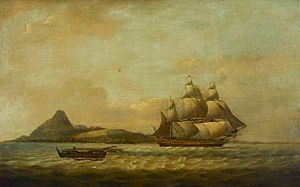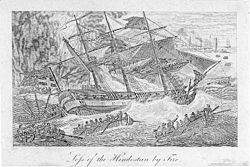HMS Hindostan (1795) facts for kids

The East Indiaman Hindostan, by Thomas Luny, National Maritime Museum
|
|
Quick facts for kids History |
|
|---|---|
| Name | Hindostan |
| Owner | Robert Williams, M.P., managing owner |
| Builder | William Barnard, Deptford |
| Launched | 3 November 1789 |
| Fate | Sold to the Royal Navy in 1795 |
| Name | HMS Hindostan |
| Acquired | 1795 by purchase |
| Fate | Lost following fire, Rosas Bay, Spain, 2 April 1804 |
| General characteristics | |
| Class and type |
|
| Tons burthen | 124875⁄94 (bm) |
| Length |
|
| Beam | 42 ft 2 in (12.9 m) |
| Depth of hold | 17 ft 1 in (5.2 m) |
| Sail plan | Full-rigged ship |
| Armament |
|
HMS Hindostan was a large sailing ship that served in the British Royal Navy. She was built in 1789 and was first known as the East Indiaman Hindostan. The British Navy bought her in 1795. This ship is famous for two main things: carrying a special ambassador to China and later being lost in a fire at sea in 1804.
Contents
Early Life as a Merchant Ship
Hindostan was launched on November 3, 1789. Her first long journey was for the East India Company. From January 1790 to June 1791, she sailed to China and back under Captain William Mackintosh.
First Voyage to China
The ship left England on January 17, 1790. She stopped in places like Madras (India) and Penang (Malaysia). She finally reached Whampoa in China on September 11. For her return trip, she sailed from China in January 1791. She stopped at Cape Town and Saint Helena before arriving back in England in June.
The Macartney Embassy
After her first trip, the British Government hired Hindostan for a very important mission. She was chosen to carry Lord Macartney to China. Lord Macartney was a special ambassador. His goal was to try and open up trade and diplomatic relations with the Chinese Empire.
This special journey lasted from October 1792 to September 1794. Hindostan sailed with another warship, HMS Lion, and a smaller ship called Jackall.
The ships left England on October 1, 1792. They made many stops along the way. These included Madeira, Tenerife, Rio de Janeiro, and Batavia (now Jakarta). They finally reached Whampoa in China on December 11, 1793. While in China, other East Indiamen ships were also there. These ships would later be bought by the British Navy, just like Hindostan.
After a long stay, Hindostan began her return journey in February 1794. She arrived back in England in September.
The British Navy bought Hindostan on March 9, 1795. They spent a lot of money to change her into a warship. She was now called HMS Hindostan. In April, Captain Robert Moorsom became her first commander in the Navy. She was sent to serve in the North Sea.
Service in the West Indies
In January 1796, a strong storm caused Hindostan to crash into another ship, Santa Margarita. Despite this, Hindostan sailed to Jamaica in the West Indies in February. There, she helped in battles against San Domingo. Captain Francis Collingswood took command in October 1796.
Hindostan returned to England in May 1797. She was then used as a guardship in Plymouth for about a year.
Becoming a Storeship
In December 1798, Captain Joshua Mulock took command. Hindostan was changed into a 28-gun storeship. This meant she would carry supplies and equipment for the fleet. She gave up her lower deck guns to make more space for cargo.
In January 1800, Hindostan sailed to the Mediterranean Sea. She carried supplies for the British fleet there. In May, she and another ship, Pearl, captured a ship called Veloce. This ship was carrying valuable goods.
Hindostan was refitted again in England from November 1800 to January 1801. She then sailed to the Cape of Good Hope in March. By May 1801, she was officially a storeship under Captain Samuel Mottley.
In September 1801, she arrived at Cape Town from Rio de Janeiro. She was part of a group of ships escorting merchant vessels. In 1804, Commander John Le Gros became her captain. He sailed Hindostan back to the Mediterranean. Her mission was to deliver supplies to Admiral Nelson's fleet.
The Loss of HMS Hindostan
In March 1804, Hindostan arrived at Gibraltar. She then sailed to meet Admiral Nelson's fleet off Toulon. She was with the frigate Phoebe, but a storm separated them.
On the morning of April 2, smoke was seen coming from the ship. The crew tried to find the fire, but they could not see any flames. Orders were given to throw the ship's gunpowder overboard. They also tried to flood the magazine, where the gunpowder was stored, but they could not.
Captain Le Gros ordered the lifeboats to be prepared. He also had the marines stand guard with loaded muskets. This was to prevent anyone from panicking and trying to escape too soon. The crew worked hard to throw overboard or wet any gunpowder they could reach.
The Ship Catches Fire
The crew fought the fire for about seven hours. They were still about 15 kilometers from shore. Suddenly, flames burst out from the ship's openings. Captain Le Gros quickly ordered the ship to be run aground. They managed to beach Hindostan in Rosas Bay, about a mile from the shore. By the time she hit the ground, she was completely on fire.
Local boats were afraid to get too close at first. But using the ship's own boats and a makeshift raft, all the passengers and crew were saved. This happened just before the ship exploded.
Spanish boats helped ferry the survivors from the ship's boats to the shore. Women and children were rescued first, then the crew, officers, and finally the captain. The evacuation was very orderly. Only three people were lost out of 259 people on board.
After the Fire
On April 19, a special naval court met to investigate the fire. Captain Le Gros, his officers, and the ship's company were all cleared of any blame. The court praised Captain Le Gros for saving so many lives. Admiral Nelson himself said that saving the crew was almost a miracle.
The cause of the fire was much discussed. Some thought it might have been caused by spontaneous combustion. This happens when materials like hemp ropes or sails catch fire on their own if they are stored when wet. Nelson later wrote that the fire must have started from medicine chests breaking or from water getting in, causing things to heat up.



